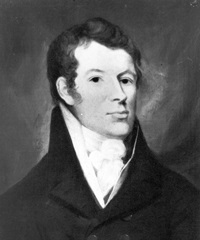
Date of Birth: 03/09/1767
Place of Birth: Stoke Damerel, near Plymouth, Devon, England
Date of Death: 11/04/1834
Place of Death: Camden Park, New South Wales, Australia
Parliamentary Service
| Member of the NSW Legislative Council |
17 Jul 1825 |
31 Dec 1832 |
7 years 5 months 15 days |
An Appointed Member of the first Legislative Council 1824 - 1843 |
Qualifications, occupations and interests
Soldier, entrepreneur and pastoralist. Sailed with the second fleet for Australia arriving in Port Jackson in 28 June 1790. Grants of land and gifts of stock assisted Macarthur to establish Elizabeth Farm at Parramatta in 1793. He returned to England with two of his children in 1802 where he canvassed the British market for wool supply. Macarthur's influence was sufficient for him to secure permission to resign from the army and return to New South Wales. He returned to Sydney and dabbled in various mercantile enterprises and by November 1812 was considerably in debt. Macarthur was appointed to the Legislative Council in 1825 and remained until 1832 when he was removed at the request of Governor Bourke on the grounds that he had been 'pronounced a lunatic', there being little hope of his restoration.
At one time Macarthur settled down to the management of his estates, and his life was comparatively tranquil. His great interest was the development of the fine wool industry. In September 1818 he mentioned that he was trying to break in his sons, James and William "to oversee and manage his affairs", but fears characteristically enough that they "have not sufficient hardness of character to manage the people placed under their control" and that "they set too little value upon money, for the profession of agriculture which as you know requires that not a penny should be expended without good reason". In 1820, writing to his son John in England, he emphasized the necessity of the colony providing exports to pay for its imports by developing the wool industry, and in 1821 suggested to Commissioner J. T. Bigge the advisability of really respectable settlers, men with capital, being encouraged to come out to New South Wales.
Macarthur was buried at Camden Park and was survived by Elizabeth, three of his sons and three daughters, two of his children having predeceased him.
Military Service
Ensign's commission in Fish's Corps. Ensign in 68th Regiment (later Durham Light Infantry), transferred as a lieutenant to the New South Wales Corps, when enlisted for duty at Botany Bay.
Membership of other Parliaments & Offices Held
Local Government Activity
Personal
Second son of fourteen children born to two expatriate Scots, Alexander Macarthur (formerly of Argyllshire) and his wife Katharine. Married Elizabeth Veale at Bridgerule in October 1788 and had issue, 8 children.
Additional Information
Australian Dictionary of Biography, Volume 2
S. Macarthur-Onslow, Early Records of the Macarthurs of Camden Park, 1914
H. V. Evatt, Rum Rebellion: a study of the overthrow of Governor Bligh by John
Macarthur and the New South Wales Corps, 1938
S. J. Butlin, Foundations of the Australian Monetary System 1788 - 1851, 1953
M. H. Ellis, John Macarthur, 1955
H. B. Carter, His Majesty's Spanish Flock, 1964
J. C. Garran, Merinos, Myths and Macarthurs: Australian Graziers and their
Sheep, 1788 - 1900, 1985
Ross Fitzgerald, Bligh, Macarthur and the Rum Rebellion, 1988
Michael Duffy, Man of Honour: John Macarthur: duellist, rebel, founding father,
2003
William Bligh, Account of the rebellion of the New South Wales Corps:
communicatesd to the Rt. Hon. Lord Castlereagh and Sir Joseph Banks, Bart..
Edited with an introduction by John Currey, 2003
Macarthur Papers, Mitchell Library, State Library of New South Wales
